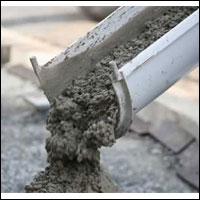As India rapidly moves on the path to urbanization with considerable increase in infrastructure and housing projects, the country’s demand for cement is projected to grow 2.5 to 2.7 times the current volumes reaching 550 to 600 million tonnes per annum by 2025, according to a recently released report by ATKearney and the Confederation of Indian Industry.
The report, titled ‘Cement Vision 2025: Scaling New Heights’, said that meeting the increase in demand would require considerable capacity addition and a sharp rise in available resources, both of which posed a challenge to the industry.
“Per capita cement consumption is likely to increase from 185 kg currently to 385 to 415 kg in 2025,” it said, adding that the growth would likely be led by investments in the infrastructure sector with subsectors such as roads, power and irrigation leading the charge.
The report said that the country’s residential sector would remain one of the largest consumers of cement with 42 to 45 percent of total demand in 2025. The demand from the sector would be driven by increasing urbanization, a rise in the number of nuclear-family households and upgrades from non-pucca to more permanent pucca houses.
Pointing out that a major shift in the overall cement customer mix was expected with share of large and direct buyers (contractors and developers) increasing from 30 percent currently to 70 percent by 2025, the report said there would be three key implications for the cement sector as a result. Firstly, the share of Ordinary Portland Cement could increase in the future since large institutional buyers and Ready Mix Cement players preferred buying OPC and doing in-house blending because of favorable cost economics. Secondly, demand for RMC could reach 25 percent of total cement demand by 2025 due to which demand for bulk cement would also get affected. The demand for bulk cement is expected to reach 20 percent of total demand by 2025. And lastly, timely onsite delivery, technical competence, relationship management and transparency in credit and commercial terms would become more important.
In order to meet the projected demand, the report said an additional capacity of 330 to 380 MTPA for cement and 240 to 270 MTPA for clinker was required by 2025, which translated to an investment close to Rs. 300,000 crore.
“An unattractive tax and infrastructure environment would make it difficult to bring in this investment,” it said, also expressing concern with regard to some of the other probable issues that were likely to challenge the industry ahead such as energy constraints, depletion of natural reserves of limestone and gypsum and logistical inadequacies.
The Indian cement industry is at present plagued by various challenges. During the past five to six years, supply-side bottlenecks have intensified. The share of linkage coal in the overall energy mix declined from 65 percent in FY06 to 35 percent in FY12 leading to increased dependence on alternative sources. The need for quality logistical infrastructure, particularly railways, along with a shortage of skilled construction labor and delays in getting land and environmental clearances have made setting up of the much-needed additional capacity difficult. High taxes on cement raise the delivered cost to the customer. These factors combined with the high costs of fuel and financing places enormous pressure on cost of cement manufacturing, which has risen 8 percent annually during the past four years. In the past two years, sluggish demand has affected cement players’ ability to pass cost increases on to the customer. While cement prices increased by a 4 percent CAGR during the past five years, operating and capital costs rose at greater rates impacting the profitability and internal rate of return of cement plants. At the current pricing and cost structure, the implied IRR of a greenfield cement plant commissioned in 2012 is estimated to be as low as 9 to 10 percent.
The report by ATKearney and CII said that with adequate government support and proactive measures, the Indian cement industry had the potential to play an instrumental role in building a modern India and could become globally admired for best-in-class efficiency, technology and processes.











